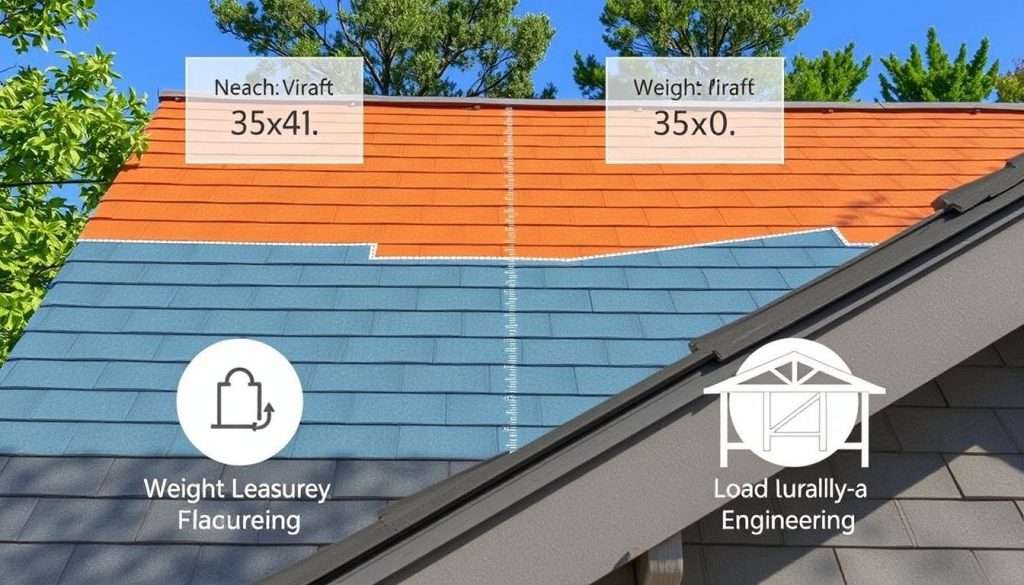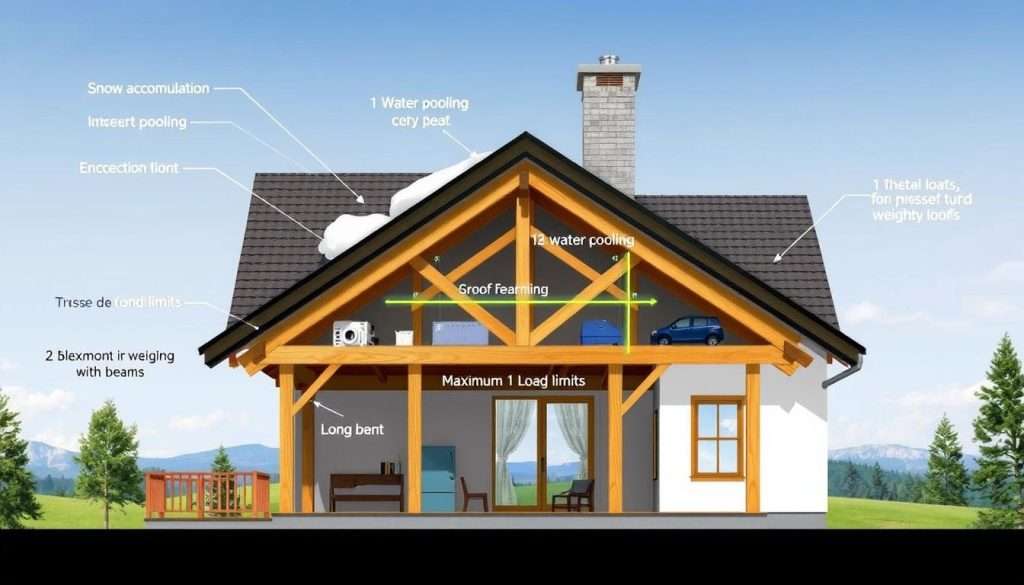Knowing how much a roof can hold is very important. It matters if you plan to walk on it or put heavy things like HVAC systems on it. The roof’s weight limit changes based on its type, materials, and local rules.
For homes, building codes say roofs can start at 20 pounds per square foot. Some can even hold up to 100 pounds per square foot. It’s key to know the roof’s weight limit to avoid problems like snow damage.
Also, checking your roof often is a good idea, especially in places with lots of snow or bad weather. This helps you know your roof’s limits and keeps it in top shape. Making your roof stronger can also help it carry more weight, keeping your home safe.
For more info on roof weight capacity, check out this link: How Much Weight Can a Roof Absorb.
Understanding Roof Weight Capacity
Knowing your roof’s weight limit is key for safety and keeping your home in good shape. It helps avoid expensive fixes and dangers. If you don’t know the limit, too much weight can damage your roof or even make it collapse.
Importance of Knowing Weight Limits
Knowing your roof’s weight limits can save your life. Most homes can handle 15-20 pounds per square foot as the dead load. You can add another 20 pounds per square foot as live load.
Local rules, like the International Building Code (IBC), set these limits. Places like Maryland follow these rules closely. This shows how crucial it is to know your roof’s capacity.
Factors Affecting Weight Capacity
Several things affect your roof’s weight limit:
- Roof design: Pitched roofs can handle more weight because of their angle.
- Building age: Older roofs may not be as strong as newer ones.
- Materials used: Lighter materials like asphalt shingles can’t hold as much as heavier ones like metal or clay tiles.
- Weather conditions: Heavy snow, rain, or wind can make your roof carry more weight, making it harder to add more.
To figure out your roof’s capacity, look at these factors closely. For example, adding wooden beams or using hurricane tie-downs can make your roof stronger.
Types of Roofs and Their Load Capacities
Knowing about different roofs is key to figuring out how much weight they can hold. Each roof type has its own special features that affect how much weight it can carry. This knowledge helps homeowners and DIY fans make smart choices about their roofs.
Flat Roofs
Flat roofs spread weight evenly over their surface. They can usually handle 20 to 100 pounds per square foot. The weight they can hold depends on the materials and design.
It’s important to keep flat roofs in good shape to avoid problems. Regular checks help keep them strong and safe.
Sloped Roofs
Sloped roofs can hold more weight because of their shape. They help keep water and snow away, which lowers the risk of too much weight. They can handle 20 to 40 pounds per square foot.
When figuring out how much a sloped roof can hold, engineers look at many things. This ensures the roof is strong and safe.
Gabled Roofs
Gabled roofs are great because of their triangular shape. This shape helps spread weight evenly, making them strong. They can hold a lot of weight, just like sloped roofs.
People like gabled roofs because they look good and work well. They are a favorite among homeowners.
| Roof Type | Weight Capacity (psf) | Characteristics |
|---|---|---|
| Flat Roof | 20 – 100 | Uniform load distribution; susceptible to snow accumulation |
| Sloped Roof | 20 – 40 | Effective water drainage; reduced overload risks |
| Gabled Roof | 20 – 40 | Excellent weight distribution; highly adaptable |
Materials That Influence Load-Bearing Capability
Knowing about roofing materials helps homeowners figure out how much weight a roof can hold. Some materials are better at carrying weight than others. This affects how well your roof works. Let’s look at what makes different materials good for roof weight.
Wood
Wood is a common choice for roofs in homes. It can hold a lot of weight but gets damaged by moisture and rot. A wooden roof can usually hold 20 to 30 pounds per square foot.
The type of wood, how it’s designed, and the spacing of trusses matter too. Choosing good materials is key for the best performance.
Metal
Metal roofs, like steel and aluminum, are very strong and light. They can hold more weight than wood, often over 50 pounds per square foot. Metal roofs also stand up well to bad weather.
Concrete
Concrete is one of the heaviest roofing materials. It can hold a lot of weight, sometimes over 100 pounds per square foot. How well it holds weight depends on how it’s built and reinforced.
Concrete roofs are great for places with changing weather. They stay strong and stable even in harsh conditions.
| Material | Average Load Capacity (lbs/sq ft) | Characteristics |
|---|---|---|
| Wood | 20-30 | Good load-bearing, susceptible to rot |
| Metal | 50+ | High strength-to-weight ratio, durable |
| Concrete | 100+ | Heavy, excellent stability in harsh conditions |
Knowing how materials affect roof weight is important for safety and function. Choosing the right roofing material based on weight capacity can make your home last longer and work better. By understanding these materials, homeowners can make better choices for their roofs.
Standard Weight Limits for Residential Roofs
It’s important to know how much weight your roof can hold. This ensures your roof stays safe and lasts long. Knowing this helps you make smart choices about upkeep, changes, and new additions.
Average Load Specifications
Most roofs can handle 20-40 pounds per square foot. This depends on local building rules. Here are some key points:
- Roofs must support at least 300 lbs as a minimum.
- Building codes say roofs should hold at least 20 pounds per square foot.
- Roofs usually support 20 pounds per square foot. Some can handle up to 100 pounds.
- Light snow weighs about 3 pounds per square foot. Roofs must handle over 6 feet of snow.
- Flat roofs can hold more weight because of their design. They must handle snow and water.
Specific Material Considerations
Roofing materials have different weight limits. This affects how much weight your roof can hold. Here are some points to consider:
- Reinforced concrete roofs can support about 1,200 pounds per square foot. This is much more than other materials.
- Clay tile or metal roofs usually hold around 27 pounds per square foot. This is less than concrete.
- How well a roof is installed, its thickness, and reinforcements affect its capacity.
- Cracks or leaks in concrete roofs can greatly reduce their weight capacity. You should fix these quickly.
- Adding 2x4s to existing trusses can make your roof stronger and last longer.

Knowing both average loads and material specifics helps keep your roof safe and working well. Always talk to a professional roofer for accurate advice. This is especially true for new roofs or repairs that might change how much weight your roof can hold.
Assessing Your Roof’s Current Capacity
Knowing your roof’s load limit is key to keeping it strong. Regular checks can spot weak spots. This keeps your home safe and sound. Let’s look at how to check your roof’s capacity, focusing on its strength and current loads.
Inspecting Structural Integrity
Regular checks are important for roof health. Look for signs of trouble, like:
- Sagging: Uneven rooflines may suggest problems.
- Cracks: Small cracks can grow into big issues if not fixed.
- Water Damage: Stains or mold mean leaks that harm the structure.
By watching for these signs, you can keep your roof in good shape. This saves you from expensive fixes later.
Calculating Existing Loads
To really know your roof’s capacity, start with a list of what’s on it. Think about:
- Dead Loads: The weight of roofing materials and any permanent stuff.
- Live Loads: Snow, wind, and people walking on it add stress.
Knowing how these loads affect your roof is key. For example, wet snow is heavier than dry. Measuring each part of your roof helps figure out how much more it can hold.
Common Roof Loads Considered
It’s key to know what roofs can handle. This keeps them strong and safe. We must understand the roof’s weight limit and how much it can hold.
Snow and Ice Accumulation
Snow can weigh a lot on roofs. Light snow adds 5 to 6 pounds per square foot. Heavy snow can be up to 20 pounds per square foot.
Ice adds even more weight. It’s important to think about these seasonal loads. They can stress the roof too much.
Equipment and HVAC Systems
Putting heavy things like HVAC systems on roofs needs careful thought. Roofs can only hold so much. Shingle roofs can handle 20 pounds per square foot.
Concrete, metal, or clay tile roofs can take up to 27 pounds per square foot. Adding too much can damage the roof. Always check the roof’s weight limit before adding anything.
Human Foot Traffic
People walking on roofs adds extra weight. Most roofs can handle normal walking. But, walking too much can harm the roof over time.
It’s smart to think about how walking affects the roof. This is especially true if the roof isn’t made for walking.

| Roof Type | Maximum Load Capacity (pounds/sq ft) |
|---|---|
| Shingle Roofs | 20 |
| Tile/Metal Roofs | 27 |
| Flat Roofs | 100 |
| Roofs with Rooftop Decks | 55 |
Tips for Enhancing Roof Weight Capacity
It’s important to make your roof strong and safe. You can do this by using smart strategies. Here are some tips to help your roof carry more weight.
Reinforcement Techniques
Using special techniques can make your roof stronger. Here are a few ideas:
- Adding trusses or beams beneath the rafters to spread out the weight.
- Using braces and extra supports to make it stiffer and stronger.
- Fixing any broken shingles to keep the roof solid.
- Applying construction adhesive for a quick fix.
Choosing Lightweight Materials
Choosing light materials helps a lot. They put less stress on the roof, so it can hold more. Think about:
- Using synthetic shingles that are strong but light.
- Choosing materials like asphalt or metal that work well.
- Picking tiles that are light but still good quality.
Using these tips can make your roof last longer and keep you safe. Spending time and money on the right materials and methods makes your home safer.
| Material Type | Average Dead Load Capacity (pounds per square foot) |
|---|---|
| Clay Tile | 27 |
| Metal | 27 |
| Shingles (Wood) | 20 |
| Synthetic Shingles | Variable, generally lower than traditional materials |
| Concrete (Commercial) | 1200 |
When to Consult a Professional
Figuring out how much weight a roof can hold is tricky. DIY checks can help, but some signs mean you need a pro. Look out for sagging roofs, ceiling cracks, or big weather damage. These signs mean your roof might not be safe anymore.
Signs You Need a Structural Engineer
Structural engineers can really check your roof. They find problems you might miss. If you think your roof can’t handle more weight, get a pro to look at it.
Benefits of Professional Assessments
Getting a pro to check your roof has many benefits. They can tell you exactly how much weight your roof can handle. This is important if you want to add things like HVAC systems or storage. They make sure your roof can handle it, so you can relax knowing your home is safe.
